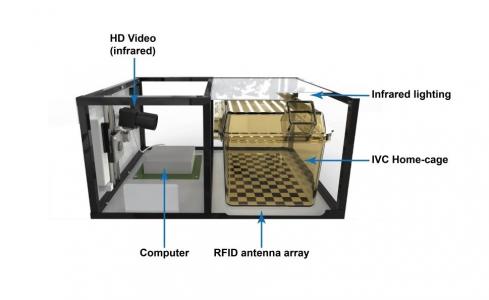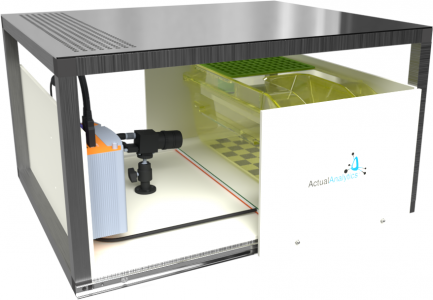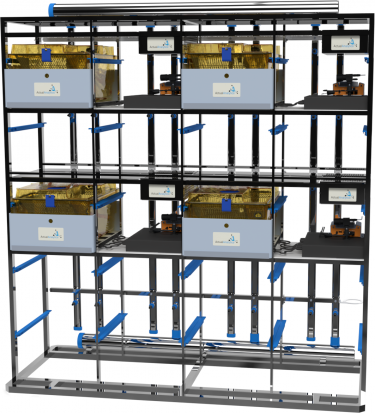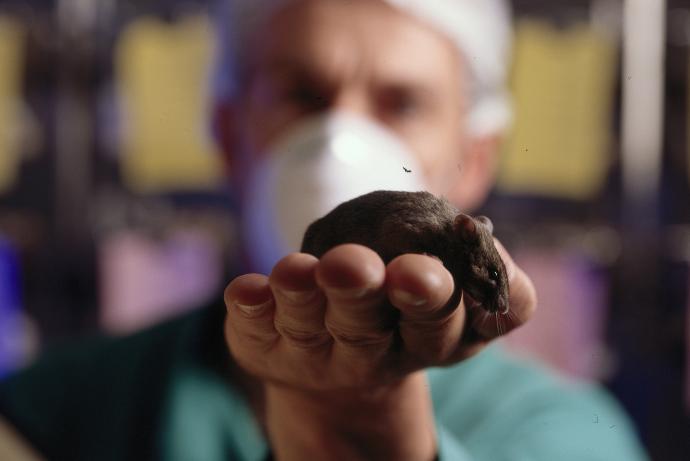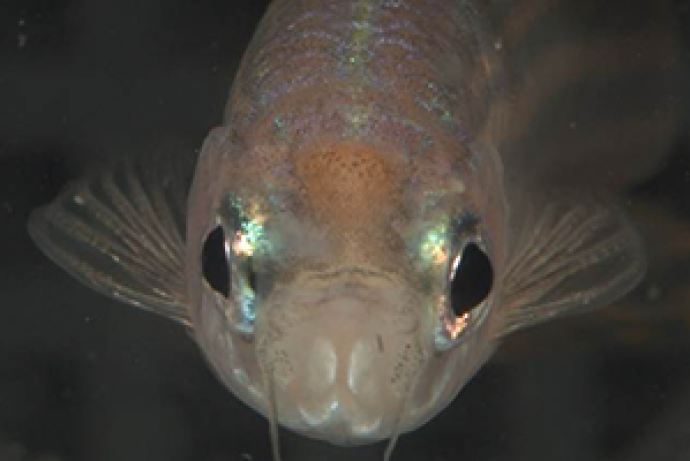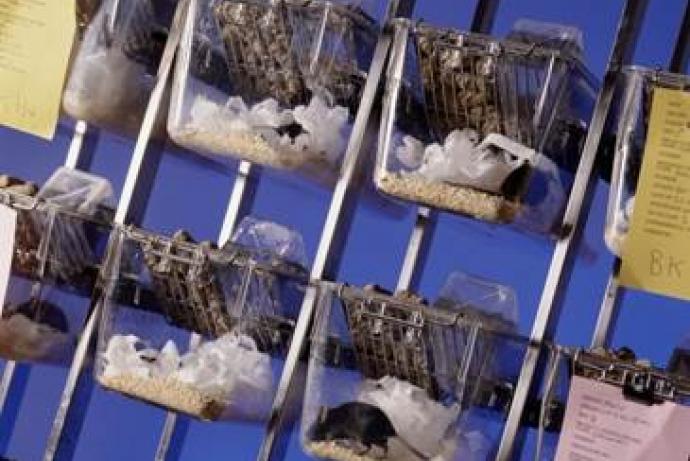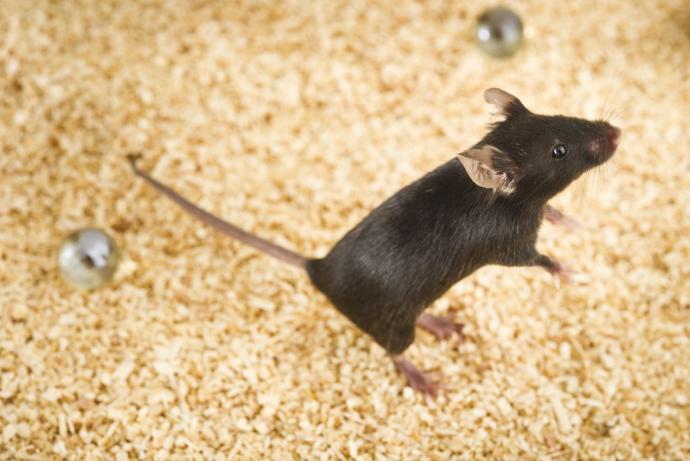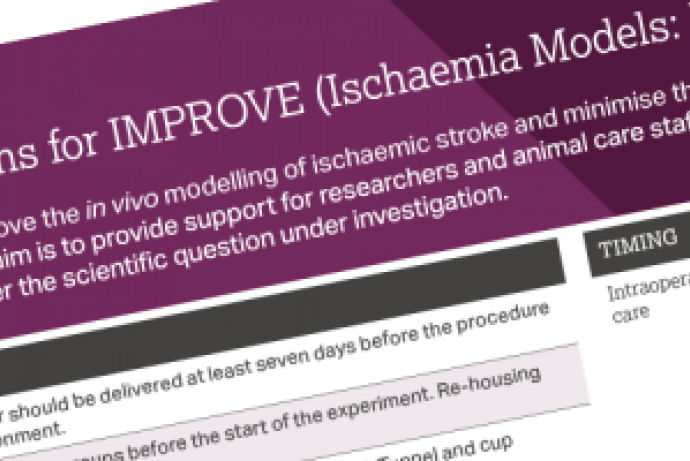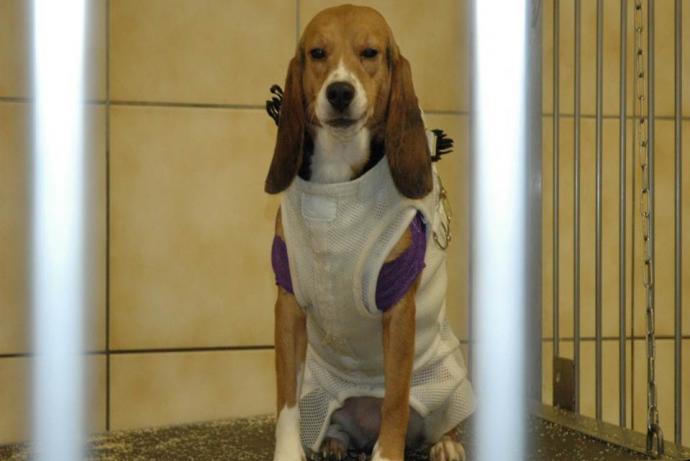Rodent Big Brother
The aim of this Challenge was to develop an automated non-surgical system, which could be used in rats and mice, to measure activity and temperature over a minimum of a 24 hour period.
To solve this Challenge, the team at Actual Analytics Ltd, led by Professor Douglas Armstrong in collaboration with the Challenge Sponsors AstraZeneca, have developed the innovative rodent home cage behavioural monitoring system, the Home Cage Analyser (HCA). The system provides minimally-invasive, 24/7 automated monitoring of individual rats' behaviour, activity and temperature while group-housed in a standard unmodified home cage.
This project and its impacts are featured as a case study in the 2019 CRACK IT Review.
10 years of CRACK IT webinar: Rodent behavioural monitoring... what have you been missing?

In May 2021, we held a webinar to highlight how the Home Cage Analyser, developed through the Rodent Big Brother and Rodent Little Brother Challenges, is being applied across multiple disciplines and sectors to refine rodent behavioural monitoring. It featured presentations by Professor Douglas Armstrong (Co-founder of Actual Analytics) and Dr Sonia Bains (MRC Harwell). The recording of the webinar is now available online, as part of our 10 years of CRACK IT celebrations.
Publication
Mitchell EJ, Brett RR, Armstrong JD et al. (2020). Temporal dissociation of phencyclidine: Induced locomotor and social alterations in rats using an automated homecage monitoring system – implications for the 3Rs and preclinical drug discovery. Journal of Psychopharmacology 34 (7): 709-15. doi.org/10.1177%2F0269881120920455
Publication
Yip P, Chapman G, Sillito R, et al. (2019). Studies on long term behavioural changes in group-housed rat models of brain and spinal cord injury using an automated home cage recording system. Journal of Neuroscience Methods 321:49-63. doi.org/10.1016/j.jneumeth.2019.04.005
Publication
Tse K, Sillito R, Keerie A, et al. (2018). Pharmacological validation of individual animal locomotion, temperature and behavioural analysis in group-housed rats using a novel automated home cage analysis system: A comparison with the modified Irwin test. Journal of pharmacological and toxicological methods 1;94:1-3. doi.org/10.1016/j.vascn.2018.03.008.
Publication
Tse K et al. (2017). Rodent Big Brother: Optimal Positioning of the Subcutaneous RFID Microchip Transponder for 24/7 Home Cage Monitoring in Rats. Journal of Pharmacological and Toxicological Methods 88;2:195. doi.org/10.1016/j.vascn.2017.09.087.
Conference presentation
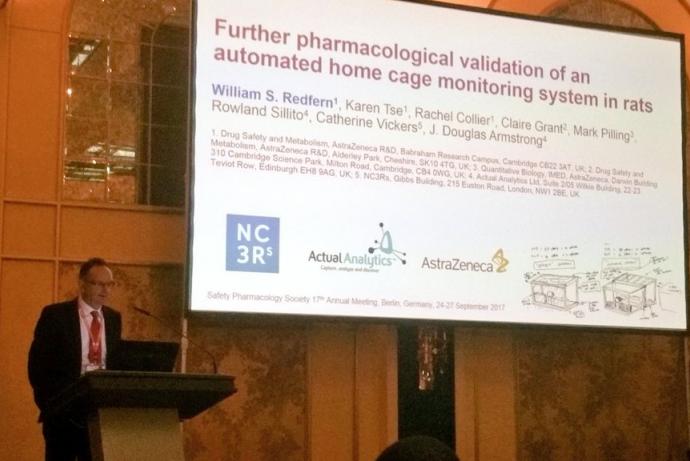
Safety Pharmacology Society Annual Meeting (Berlin, Germany)
Further pharmacological validation of an automated home cage monitoring system in rats.
Webinar
BIA Webinar
Funding and solving R&D challenges with NC3Rs, AstraZeneca and Actual Analytics.
Publication
Redfern WS, Tse K, Grant C, et al. (2017). Automated recording of home cage activity and temperature of individual rats housed in social groups: The Rodent Big Brother project. PloS one 12(9): e0181068. doi.org/10.1371/journal.pone.0181068.
In collaboration with AstraZeneca and Actual Analytics, the NC3Rs hosted a one-day workshop in central London on 5 June 2017 to showcase the rodent Home Cage Analyser system, developed by Actual Analytics through the Rodent Big Brother CRACK IT Challenge.
Conference presentation
British Pharmacology Society Annual Meeting (London, UK)
Conference presentation
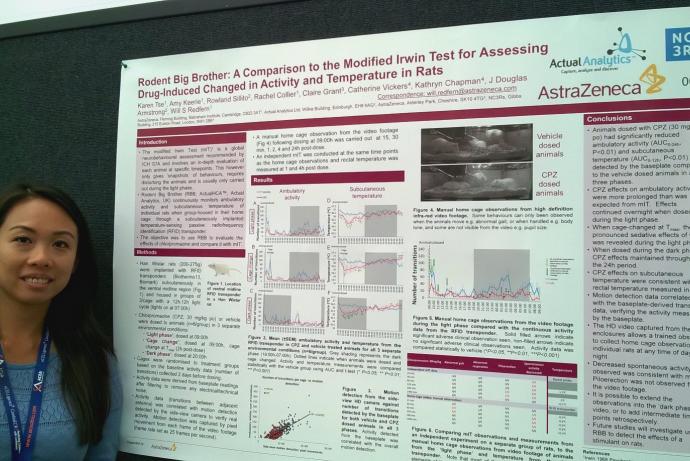
2016 Annual Safety Pharmacology Society (Vancouver, Canada)
Karen Tse presented three posters on the Rodent Big Brother Challenge at the 2016 Annual Safety Pharmacology Society meeting in Vancouver.
Watch the Inside Scientific webinar ‘24/7 Automated Behavior Tracking for Rodent Safety Pharmacology and Phenotypes’ showcasing the RBB CRACK IT Challenge.
CRACK IT Solutions funding awarded
Funded through CRACK IT Solutions, Actual Analytics is working with researchers from Queen Mary, University of London to expand the scope of the RBB system and validate it for longitudinal monitoring of home-cage behaviours in animals that have undergone spinal cord injury procedures.
Publication
Redfern WS, Armstrong JD, Heward J, et al. (2014). Rodent big brother: Development and validation of a home cage automated behavioural monitoring system for use in repeat-dose toxicity studies in rats. Toxicology Letters (229):S47-8. doi 10.1016/j.toxlet.2014.06.206.
CRACK IT Solution
Actual Analytics is seeking partners to help validate and extend the scope of their innovative home cage analysis system through CRACK IT Solutions.
Publication
Redfern WS, Ewart LC, Lainée P, et al. (2013). Functional assessments in repeat-dose toxicity studies: the art of the possible. Toxicology Research 2(4):209-34. doi:10.1039/C3TX20093K.
Product launched

ActualHCATM is a 24/7 automated monitoring system for socially grouped animals in their home-cages.
Challenge completed
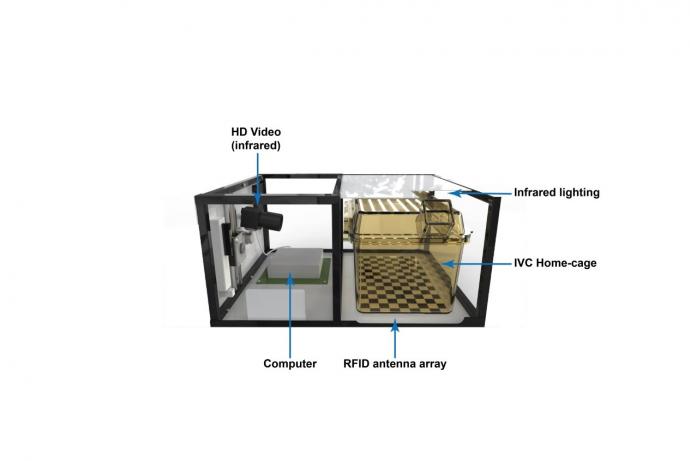
Actual Analytics Ltd in collaboration with Challenge Sponsors AstraZeneca has developed the innovative rodent home cage behavioural monitoring system, the Home Cage Analyser (HCA). The system provides minimally-invasive, 24/7 automated monitoring of individual rat’s behaviour (ambulatory activity, eating, drinking and rearing) and temperature while group-housed in a standard unmodified home cage.
Challenge awarded
A team led by Professor Douglas Armstrong, Actual Analytics Ltd - a spin-out company from the University of Edinburgh, has been awarded £500k to deliver the project: The Trurat Show.
Challenge launched
Sponsored by AstraZeneca, the Rodent Big Brother Challenge aims to develop an automated non-surgical system, which can be used in rats and mice, to measure activity and temperature over a minimum of a 24 hour period.
Background
Measurement of the activity of individual rats or mice in their home cage provides useful information in studies from basic research through to drug discovery and development. This includes:
- Detecting and assessing toxicological effects (for example effects on the central nervous system) of candidate drugs, including physical dependence.
- Characterization of agents targeting disorders of the CNS.
- Behavioural phenotyping of genetically altered animals.
- Studies of circadian rhythms.
Measurement of body temperature in rodents may also be used in each of the research applications above; particularly for some toxicology studies and the assessment of physical dependence. Activity and temperature can currently only be measured separately, unless surgically implanted telemetry devices are used; however the surgery required places an additional welfare burden on the animals. Activity can be measured non-invasively using transparent cages and photocell beams or infrared movement sensors, or by placing the cages on mechanical sensor platforms. However, this requires animals to be singly housed, which is not ideal for social species such as rats and mice which live in groups.
Video tracking systems, with individuals marked with different colours, can be used for group-housed rodents but these methods are not readily incorporated into standard caging with wire mesh lids, especially when measuring simultaneously from multiple cages; also, video tracking in darkness requires infrared lighting, which would not enable discrimination between individuals marked with different colours. The aim of this challenge is to develop an integrated system which combines measurement of activity and temperature in rodents that can be used with group housing and without surgery.ID microchip transponders which measure temperature already exist and may potentially be utilised for this challenge. These chips are about 14 mm x 2 mm, and are injected subcutaneously in the nape of the neck. Examples include the IPTT-300 (PLEXX, Netherlands; BioMedic Data Systems Inc., USA). Accelerometers have been used to record and characterise behavioural movements in rodents, but so far only when worn externally.
3Rs benefits
The development of a non-surgical, automated approach to measure activity and temperature in animals supports reduction and refinement by avoiding the need for surgery or single housing. It would enable incorporation of these additional measurements into existing study types, thereby reducing the number of separate standalone studies. It could potentially impact on the welfare of thousands of animals. More broadly, this technology could also be used to provide additional information for other studies where early identification of animals with subdued activity or changes in body temperature could be used to improve humane endpoints.
Challenge Winner
Project team led by:
Full Challenge information
Actual Analytics Ltd in collaboration with Challenge Sponsors AstraZeneca has developed the innovative rodent home cage behavioural monitoring system, the Home Cage Analyser (HCA). The system provides minimally-invasive, 24/7 automated monitoring of individual rat’s behavior (ambulatory activity, eating, drinking and rearing) and temperature while group-housed in a standard unmodified home cage. When used in safety pharmacology studies, the system avoids the need for surgery or single housing, reduces the number of animals needed, delivers welfare benefits to the animals used and, through the incorporation of additional measurements into existing study types, reduces the number of studies needed overall.
The HCA system fits into two rack spaces of standard IVC racks without modifying the home cage (Figure 1). Each animal is tagged subcutaneously in the ventral midline with a radiofrequency identification (RFID) chip to record temperature, location and identity using a 2D array of RFID readers that sit underneath each cage. The cage is illuminated by infrared LED lighting and a side-view HD camera captures recordings of rat behaviour. The video and baseplate data is processed using a small computer, and trained software detects specific behaviours.
Figure 1. An illustration of the Home Cage Analysis system with the key components highlighted.
AstraZeneca conduced proof-of-principle studies of the HCA system using three reference drugs (chlorpromazine and clonidine (sedatives), and amphetamine (stimulant)) and demonstrated that the HCA could detect changes in ambulatory activity, vertical activity and subcutaneous temperature in group housed animals consistent with effects seen in the conventional modified Irwin test (mIT), but extending into the 24 hour profile (Tse et al., 2018). The HCA also detected effects that were missed by the mIT, highlighting the benefits of continuous monitoring.
Although the system was developed initially for use by the pharmaceutical industry to support safety studies, the system also has broad applicability across a wide range of research areas including phenotyping and pharmacological profiling of new disease models.
Actual Analytics was awarded the contract for the CRACK IT Challenge Rodent Little Brother and has developed a system for mice.
Actual Analytics was been awarded funding through the NC3Rs technology partnering hub CRACK IT Solutions to expand the scope of the system. Actual Analytics worked with researchers from Queen Mary, University of London to validate the system for longitudinal monitoring of home cage behavior and welfare in animals undergoing spinal cord or brain injury procedures https://www.nc3rs.org.uk/rodent-big-brother.
The NC3Rs in collaboration with Actual Analytics and AstraZeneca held a one day workshop to showcase the rodent HCA system to potential industry users. Further information can be found here.
The HCA system for rats and mice is commercially available to purchase and has been implemented by a number of CROs, research institutes and pharmaceutical companies. For more information about the HCA system, please visit the Actual Analytics website or alternatively contact Actual Analytics at getintouch@actualanalytics.com.
ActualHCATM
Product description
The Actual Analytics Home Cage Analyzer (ActualHCA) represents a significant and exciting breakthrough in the technology available for rodent behavioural research. In the past, measuring most behaviours in rodents meant they had to be housed singly, in bespoke arenas. Analysis was limited to the designated hours of observation, typically during the day, meaning researchers obtained little more than an artificial snapshot of the rodents’ activity and behaviour.
With ActualHCATM, it is possible to gather data on a 24/7 basis in the least invasive manner possible, while the rodents remain in their normal home cage. The system provides automated analysis of discrete behaviours, body temperature and locomotor activity tagged to each individual animal within their normal social group. Live analysis of activity and temperature patterns can be used to trigger custom defined welfare alerts or experimental end-points.
Testing within the home cage is suitable for a number of interest areas, including but not limited to:
- Detecting and assessing safety/toxicological effects of candidate drugs.
- Behavioural phenotyping of genetically altered animals.
- Longitudinal analysis of animal cohorts across many months.
- Drug efficacy studies.
- Studies of circadian rhythms.
- Studies of social interactions.
3Rs benefits
Reduction: The quantity of longitudinal data gathered provides additional statistical power, meaning fewer animals are required. Multiple endpoints can be collected concurrently using a single group of animals (e.g. locomotion and temperature in the same group) reducing total numbers.
Refinement: The behavioural data collected is entirely non-invasive and based on identifying individual behaviour in the home cage and does not require social isolation of the animals. Remote observation capabilities facilitate enhanced welfare monitoring. Live data analytics can flag potential welfare issues in real time.
Features



